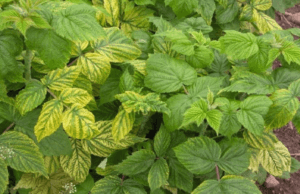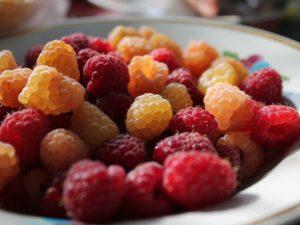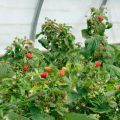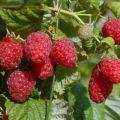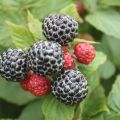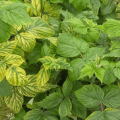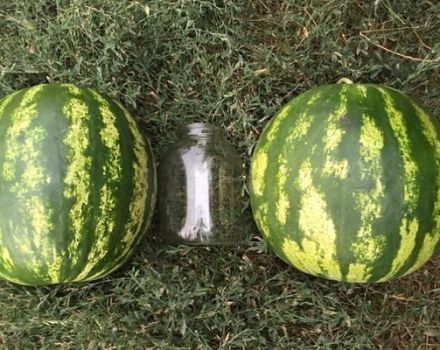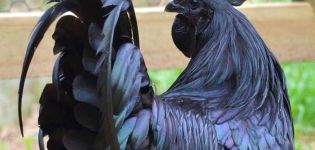Description of varieties of red raspberries, the best large-fruited and remontant species
Red raspberry is a unique, valuable berry crop, which has thousands of cultivars and dozens of wild ones. Both one and the other with medicinal properties from the roots to the crown with fruits.
Content
- 1 Advantages and disadvantages of red-fruited culture
- 2 Varieties of varieties depending on the ripeness
- 3 Raspberry varieties with double berries
- 4 High-yielding varieties
- 5 Frost-hardy and winter-hardy
- 6 Large-fruited
- 7 The sweetest and most delicious varieties
- 8 Disease and Pest Resistant Crops
- 9 Varieties with good transportability
- 10 Varieties of new selection
- 11 How to choose the best variety depending on the region
Advantages and disadvantages of red-fruited culture
In raspberries of red-fruited varieties, the varieties differ in their characteristics from others in the size of berries, resistance to frost, pests, diseases, in the degree of sugar accumulation in the berries and their size, as well as in species, ripening times and recommended planting regions.
Red raspberries have several advantages over yellow and black berries:
- Traditional varieties grow faster.
- Resistant to temperature extremes and frosts down to -40.
- Berries have more vitamin C and lower calories.
- The taste of berries is usually sour.
- Bushes are undemanding to growing conditions.
- It is easy to propagate, as lateral shoots give well.
Disadvantages of red raspberry varieties:
- Traditional varieties are less productive.
- Large-fruited red raspberries poorly develop lateral shoots.
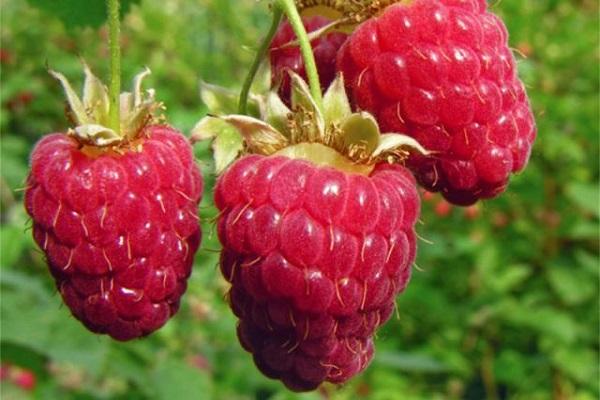
Varieties of varieties depending on the ripeness
The berry is also classified according to the ripening period.
Early varieties
Early raspberry varieties begin to bear fruit from the second half of June to the 1st decade of July on old, two-year-old shoots. These include:
- Scarlet sails - the size of the fruits is small, up to 2.7 g, but frost resistance and yield (up to 2 kg) are high. Shoots are highly branched, but with fewer thorns.
- Bryanskaya - sturdy stems, slightly branched. The berries are tasty, medium-sized, up to 3 g. By the number of berries harvested per season, they are classified as medium-yielding. Medium disease resistance.
- Lazarevskaya - bushes differ in the height of the shoots, which do not exceed 1.8 m, branched. Berries are larger than average in size, up to 3.5 g, up to 2.2 kg are removed from the bush per season. Not suitable for long-term transportation. Poorly tolerates severe frosts, requires shelter. Often exposed to disease.
- Meteor - begins to bear fruit very early, in the second half of June with medium-large berries up to 3 g. Harvesting is amicable, up to 2.5 kg. Fungal diseases are almost not affected, it is attacked by pests. It tolerates winter frosts well.
- Kuzmin's news - with an average yield, the variety is characterized by increased resistance to many diseases and pests, sharp temperature changes, and severe winters.
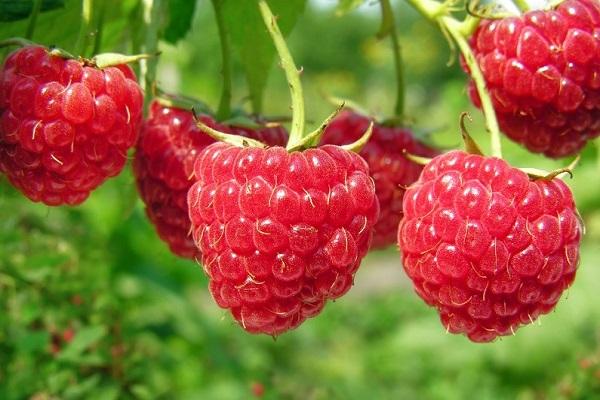
It also includes: Novokitaevskaya, Vega, Solnyshko, Michurinskaya dessert, Early dawn, Early surprise, Flame, Early sweet.
Middle ripening period
Red raspberries with an average ripening period begin to ripen from the beginning of June to the second half of August, they include mid-early and mid-late varieties, in which time may shift depending on weather conditions and the growing region:
- Balm - tolerates northern winters favorably, shoots do not vomit and do not dry out. Berries are larger than average, up to 2.8 g, yield up to 2.2 kg. It is rarely attacked by pests and diseases.
- Gloria - bushes are very tall and spreading, strong. Berries of large sizes, up to 4 g. Harvest up to 90 kg from 1 are. Indicators of resistance to diseases and frost are average.
- Shy - compact bushes, on the branches you can very rarely see thorns. Weather changes do not affect the amount of the crop, it is always stable, with medium-sized berries, up to 2.9 g. The main pest is the spider mite. It exhibits strong immunity to fungal diseases.
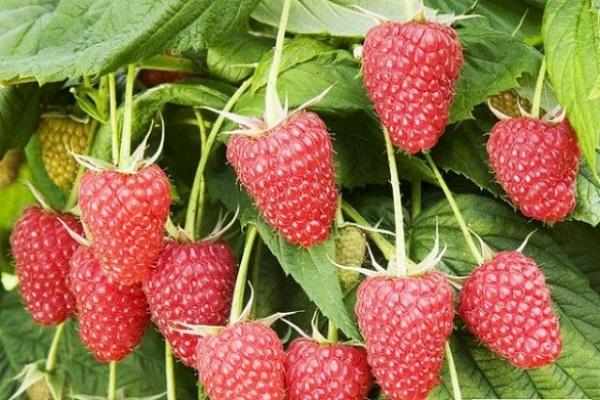
With an average maturity, varietal red raspberries are distinguished: Kaliningrad, Visluha, Glen Prosen, Cleopatra, Glen Ampl, Gloria, Volnitsa, Za Zdravie, Gusar, Iskra, Kirzhach, Tenderness.
Late
Ripening of late varieties of red raspberries begins in August:
- Brigantine - compact shrubs, from which up to 2.2 kg of large berries are harvested, more than 3 g. Taste qualities received a tasting rating 4. Winter hardiness and the possibility of infection with diseases are average.
- Ruby is a Bulgarian variety with high taste and characteristics, very large fruits, sometimes reaching 4 g. Fruiting is stable even in the presence of diseases to which it exhibits weak immunity. Average winter hardiness.
- Companion - with good tolerance and susceptibility to diseases, the bushes show an average degree of resistance to frost, although the fruits reach a weight of 3.5 g and a yield of up to 2 kg.
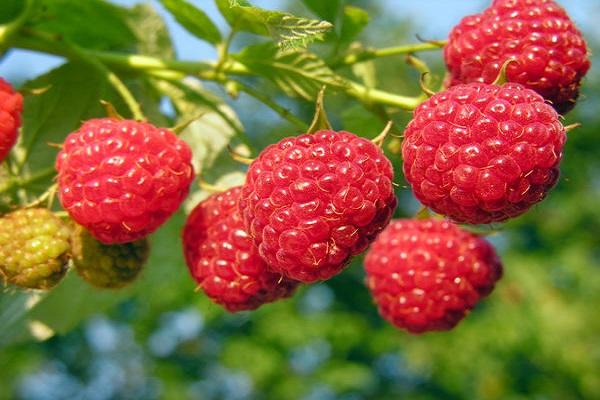
Peresvet, Mirage, Stolichnaya ripen later than other varieties of red raspberries, starting from the first or second decade of August.
Repaired
The varieties of remontant red raspberries are distinguished by a long fruiting period and high productivity of bushes, as well as less disease. Thanks to them, berries can be consumed throughout the summer and autumn period:
- Penguin - ripens from June on compact bushes with large berries up to 5 g, high productivity, up to 2.5 kg per bush. Highly winter-resistant, the main pests and diseases of the genus Rubus hardly affect.
- Hercules - from August until the first frost, the culture gives up to 80% of ripe berries of a very large size, the productivity of the bushes is up to 2.5 kg. Differs in high rates of immunity against diseases and pests.
- Kalashnik - rich-yielding, up to 3 kg, with unusual taste of medium-sized fruits, up to 3 g. Favorably tolerates frost at -30, dry weather, major diseases.
Indian summer, Indian summer 2, Bryansk jubilee, Mulatka, Eurasia - remontant varieties with large red fruits.
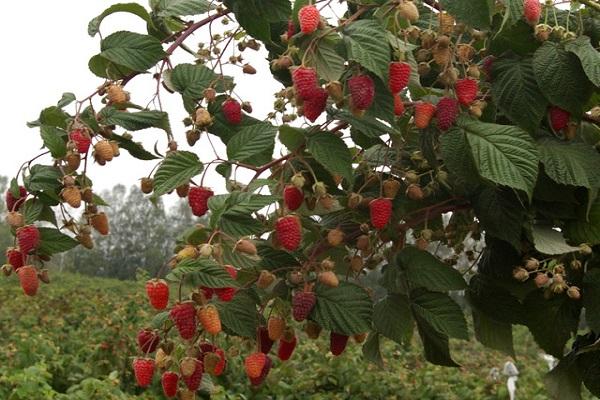
Raspberry varieties with double berries
Double berries are a varietal trait, but sometimes this phenomenon occurs on bushes with large raspberries or early ripening varieties due to high humidity in spring or a viral infection:
- Double - a late-ripening Belarusian variety, the productivity of the bushes is high, up to 12 tons per hectare, but at the same time weak resistance to frost. The first fruiting produces amazing double berries.
- Giant is a remontant variety with very large berries, up to 15 g, respectively, and the productivity is very high, up to 12 tons per hectare.The peculiarity of the fruits is the formation of double ruby berries of an elongated-oval shape.
- Patricia - with large berries, 11-14 g, does not belong to remontant, but fruiting lasts from June to the end of August, up to 5 kg of ripe fruits are removed from one bush per season, sometimes double.
- Volnitsa - remontant, with cone-shaped berries, often accrete at the first fruiting, weighing 3-5 g.
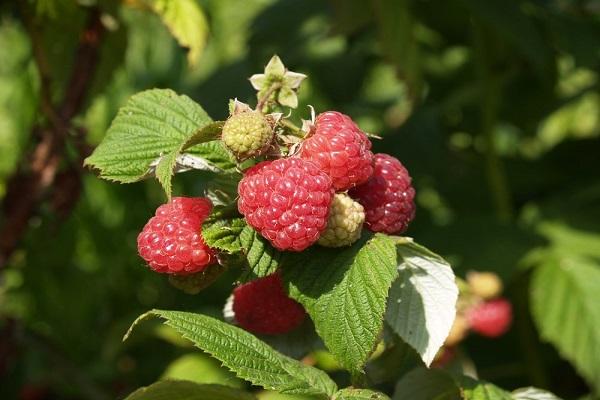
Sometimes the berries can double in the Maroseyka and Kras of Russia varieties.
High-yielding varieties
A high-yielding raspberry variety that brings more than 10 tons per hectare. In Russia, raspberry varieties with large fruits and high yields are popular: Penguin, Giant Rubinovy, Arbat, Anfisa, Golden Giant, Pride of Russia, Award:
- Tarusa - large berries, 7-9 g, cone-shaped, with a pleasant tart-sweet taste and light aroma. Withstands frost down to -32, almost not affected by diseases.
- Firebird - productivity up to 16 tons per hectare, ripening later, from the 2nd decade of August.
- Kirzhach - berries up to 6 g, tall, powerful bush, up to 2.5 m. Medium resistance to frost up to -25.
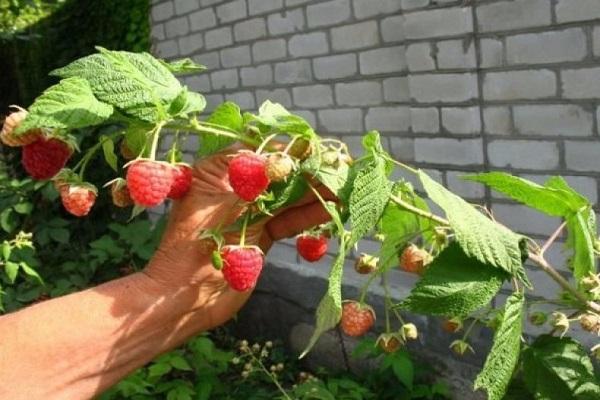
Frost-hardy and winter-hardy
The concept of winter hardiness and frost resistance determines the ability of raspberries to survive unfavorable winter conditions, sudden temperature changes without damage, these include some of the best: Scottish, Patricia, Barnaul, Pride of Russia, Anfisa:
- Hussar is tall, up to 2 m, fruits up to 4 g, resistant not only to adverse winter conditions, but also to diseases, pests and drought.
- Abundant - berries are elongated-oval, from 4 to 10 g, the taste is pleasant, bright, sweet. Resistant to major pests and diseases.
Large-fruited
Large-fruited raspberry varieties are obtained thanks to the L1 gene: Patricia, Krepysh, Izobilnaya, Tarusa, Arbat, Maroseyka, Hercules, Taganka, Stoleshnik, Sokolitsa, Giant Ruby:
- Ruby necklace - berries from 4 to 9 g, yield up to 17 t / ha.
- Aboriginal - fruits of a conical shape, 4-8 g. Stems are powerful, without thorns, strong, up to 2 m.
A distinctive feature of all varieties with large fruits is the elongated sepals during flowering.
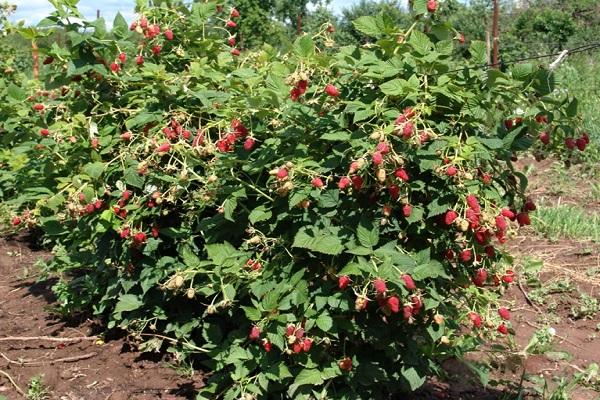
The sweetest and most delicious varieties
The taste of the berry depends on the harmony of the combination of the amount of sugar accumulation and the acid in them. The most delicious fruits of raspberries are considered with the accumulation of sugar over 8% and acidity less than 3%. The sweetest varieties of raspberries, according to gardeners:
- Tarusa;
- Praise;
- Zyugan;
- Caramel;
- Polka;
- Sun;
- Hercules;
- Daughter of Hercules.
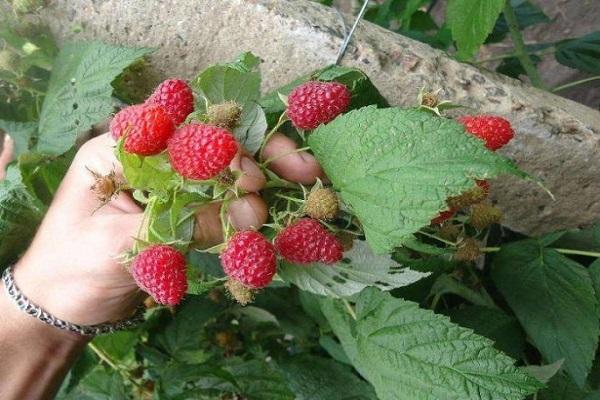
Disease and Pest Resistant Crops
Resistance to damage by pests and disease is tested for 5-10 years at experimental stations. Disease and pest resistant raspberry varieties: Gusar, Balsam, Michurinskaya dessert, Arbat, Glen Ampl, Patricia, Solnyshko.
They are not exposed to fungal diseases, but are poorly resistant to viruses and pests: Meteor, Cascade, Volnitsa, Novokitaevskaya.
Varieties with good transportability
Well-transportable berries should have a denser structure of polystyads, often such fruits have a glossy surface: Abundant, Lashka, Early Zarya, Glen Prosen.
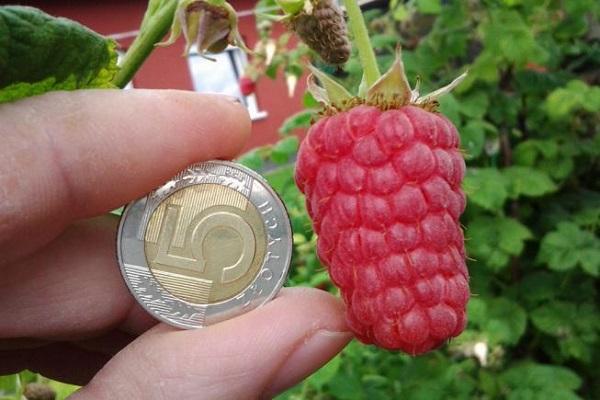
Varieties of new selection
Trials of raspberry bushes can take several years, but until they are registered, they are usually little used by gardeners and farmers. After entering the register, these bushes are assigned a number and called a new variety: Fairy Tale, Beauty of Russia, Maroseyka, Brusvyana.
How to choose the best variety depending on the region
The yield of the bushes, the absence of diseases and freezing will depend on the correctly selected variety for the climatic conditions of the region in which the plant is planned to be planted. They are selected for adaptive qualities: winter hardiness, drought resistance, soil characteristics, sharp temperature changes.
Moscow region and central strip
The middle zone of Russia is its European part. It is advised to grow in this strip: Arbat, Tarusa, Maroseyka, Lyashka, Scottish, Aboriginal, Beauty of Russia, Pride of Russia, Kalashnik. Sweet varieties of red raspberries for the middle lane: Inaccessible, Sun, Monomakh's Hat, Eurasia, Kokinskaya.
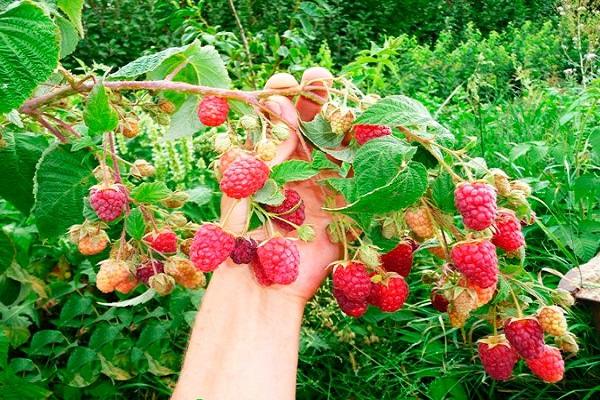
For Siberia and the Urals
For Siberia and the Urals, red raspberry varieties should be distinguished by high frost resistance, quick adaptive ability, resistance to damping, and the ripening period of berries to frost. Early, middle, middle-late: Barnaulskaya, Ogonyok of Siberia, Gift of Siberia, Kirzhach, Zorenka Altai, Nagrada, Volnitsa, Modest, Zhuravlik, Tourmaline.
For Altai Territory
The southeastern part of Western Siberia - Altai Territory, with short hot summers and prolonged cold winters requires a high degree of stability from raspberries. Choose: Illusion, Barnaul, Bryansk, Kuzmin's News, Visluha, Vislukha's Daughter, Canby.

For southern regions
Experts recommend planting red-fruited raspberries for the Southern Federal District, Astrakhan, Volgograd, Rostov regions, the Republics of Adygea, Kalmykia and the Crimea and Krasnodar Territory: Indian Summer, Indian Summer-2, Zhuravlik, Diamond, Firebird, Hercules, Polana, Bryansk Divo, Heritage, Penguin, Ruby necklace.
